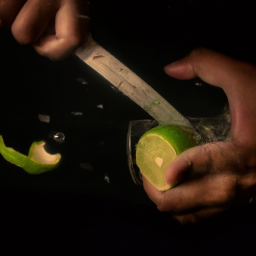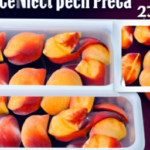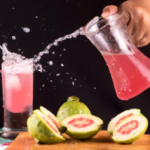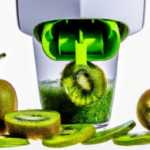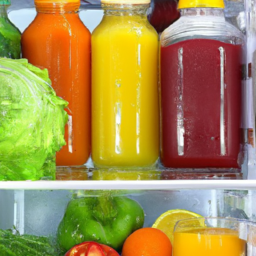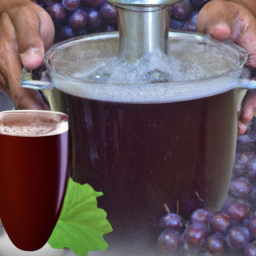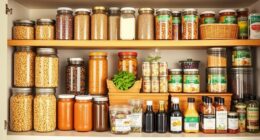Juicing is a great way to get all the necessary nutrients and vitamins from fruits and vegetables in one delicious drink. In this article, I’m thrilled to share with you the process of juicing a peach, which is one of my favorite juices to make.
Not only is peach juice refreshing and tasty, but it also has many health benefits, such as promoting healthy skin and digestion, and improving immunity.
Before we get started, it’s important to choose the right peaches. Look for peaches that are ripe, but not too soft, and have a fragrant smell. The color of the peach should be a deep yellow or orange, depending on the variety.
Once you’ve picked out your peaches, it’s time to clean and prepare them for juicing.
Key Takeaways
- Choosing ripe peaches is important for a flavorful juice.
- Adding natural sweeteners and experimenting with flavors can enhance the taste of peach juice.
- Storing peach juice in an airtight container in the refrigerator can prevent spoilage.
- Juicing peaches can provide numerous health benefits, including improved skin, digestion, and immunity.
Selecting the Right Peaches
You’ll wanna choose peaches that are firm but yield to gentle pressure, and have a fragrant aroma. When selecting peaches, the ripeness level is crucial. If the fruit is too ripe, it’ll be too soft to juice and may not have the desired sweetness.
On the other hand, if it’s not ripe enough, it won’t have the full flavor and may be too tart. You’ll want to look for peaches that are just starting to soften, but still have some firmness.
Additionally, the seasonal availability of peaches is important. Peaches are typically in season from May to September, so it’s best to juice them during this time when they’re at their freshest. You can also find imported peaches during the off-season, but they may not be as juicy or flavorful.
Once you have selected the perfect peaches, it’s time to move on to cleaning and preparing them for juicing.
Cleaning and Preparing the Peaches
First, grab a soft-bristled brush and gently scrub the skin of the peach under cool running water. This will help remove any dirt or debris that may be on the surface of the fruit. Once you have done this, you can move on to removing the fuzz from the skin. To do this, you can use a small knife or peeler to gently scrape away the fuzz. Be careful not to remove too much of the skin in the process.
After you have removed the fuzz, rinse the peach thoroughly under cool running water. This will help ensure that all the dirt and debris has been removed from the fruit. Once you have rinsed the peach, pat it dry with a clean towel. Now your peach is ready to be cut and juiced. In the next section, we will discuss how to cut the peaches in order to get the most juice out of them.
Cutting the Peaches
Now that the peaches are clean and fuzz-free, it’s time to slice them up so you can savor their sweet flavor in every bite. The first step is to choose ripe peaches that yield slightly to pressure when pressed gently with your fingers. They should also have a fragrant aroma and a rich color. If the peaches aren’t ripe enough, they’ll be hard and difficult to slice.
When it comes to cutting the peaches, you’ll need a sharp knife and a cutting board. Hold the peach firmly with one hand and make a lengthwise cut around the pit, starting at the stem and ending at the bottom. Twist the two halves in opposite directions to separate them. If the peach is very ripe, you can simply pull the halves apart with your hands.
Remove the pit by cutting around it with the tip of your knife. Then, slice the peach halves into wedges or cubes, depending on your preference. Once you have all the peaches cut and prepared, it’s time to move on to choosing the juicer.
Choosing the Juicer
As you search for the perfect tool to juice your peaches, it’s important to consider the different types of juicers available. Manual juicers, such as citrus presses, require physical effort to extract the juice, while electric juicers use motors to do the work for you. Both options have their pros and cons.
When it comes to manual juicers, they’re generally less expensive, easy to use, and don’t require electricity. However, they may not be as efficient at extracting juice, and can be tiring to use for larger quantities. On the other hand, electric juicers can extract juice quickly and efficiently, but they can be more expensive and require electricity.
It’s important to weigh these factors and consider your personal preferences when choosing the right juicer for your peach juicing needs.
With your juicer in hand, it’s time to move on to setting it up for use.
Setting Up the Juicer
I’m going to talk about setting up the juicer, which involves two key points: assembling the juicer and placing the container under the spout.
Assembling the juicer may seem daunting at first, but it’s actually quite simple if you follow the instructions carefully.
Once you have the juicer assembled, the next step is to place a container under the spout to catch the juice.
Assembling the Juicer
Congratulations, you’ve made it to the most thrilling part: putting together the juicer! Before we begin, let’s make sure we’ve got all the necessary cleaning tools and have taken all safety precautions.
The juicer should be thoroughly cleaned and dried before assembly to prevent any contamination. Make sure to also read through the instruction manual to avoid any accidents or damage to the machine.
Once we have all the tools and have taken safety precautions, it’s time to assemble the juicer. First, we need to attach the feeding tube and make sure it’s secure.
Then, we attach the juice strainer to the juicer’s base and lock it in place. Finally, we attach the lid and make sure it’s firmly locked in place.
If there are any issues during assembly, refer to the troubleshooting section in the instruction manual or reach out to customer service for assistance.
Now that the juicer is assembled, let’s move onto the next step of placing the container under the spout.
Placing the Container Under the Spout
Now that the juicer’s assembled, it’s time to place a container under the spout to catch the delicious and nutritious beverage. This is an important step in the juicing process as it ensures that you don’t waste any of the precious juice and also prevents spills from occurring.
I usually use a glass or plastic container with a wide mouth to make it easier to pour the juice into glasses or bottles later. When placing the container under the spout, make sure it’s positioned correctly so that the juice flows directly into it.
You don’t want any juice to spill out onto the counter or floor as this can create a mess and also waste the juice. Once the container is in place, you can proceed to the next step of juicing the peaches.
Juicing the Peaches
To get started on juicing your peaches, simply wash and dice them into small pieces. Here are four key things to keep in mind while juicing your peaches:
-
Peach juice benefits: Peaches are packed with nutrients that are great for the body. They contain vitamins A and C, fiber, and potassium, making them an excellent addition to any juice recipe.
-
Best time to juice peaches: The best time to juice peaches is when they’re ripe. Look for peaches that’re slightly soft to the touch and have a sweet aroma.
-
Preparing the peaches: Before juicing the peaches, remove the pits and dice them into small pieces. This’ll make it easier for the juicer to extract the juice.
-
Juicing the peaches: Once the peaches are prepared, simply add them to the juicer and turn it on. The juicer’ll extract the juice from the peaches, leaving behind any pulp or skin.
Incorporating fresh peach juice into your diet is a great way to boost your nutrient intake and add a sweet and refreshing flavor to your day. Now, let’s move on to the next step of adding sweeteners (optional) to your peach juice.
Adding Sweeteners (Optional)
If you want to give your peach juice an extra boost of sweetness, adding natural sweeteners is the way to go. While the natural flavor of peaches is already sweet, adding a teaspoon of honey or a dash of agave nectar can elevate the taste to a whole new level.
Not only do these sweeteners add flavor, but they also provide additional health benefits. When adding sweeteners, it’s important to consider the juice consistency. If the juice is too thick, it may be difficult for the sweetener to mix evenly. In this case, it’s best to dilute the juice with a small amount of water before adding the sweetener.
Once the juice and sweetener are mixed together, give it a taste test and adjust the sweetness to your liking. With a little bit of honey or agave nectar, you can create the perfect balance of sweetness in your peach juice.
Now that we’ve added some sweetness to our peach juice, it’s time to mix things up with some additional flavors.
Mixing Flavors (Optional)
Spice up your peachy beverage by blending in some complementary flavors, and let your taste buds dance with joy! Mixing techniques are essential in creating a balanced and flavorful juice.
When it comes to mixing flavors, there are a few things to consider. First, think about what flavors complement peaches. Citrus fruits like lemon or lime can add a tangy and zesty kick to your drink. Berries like strawberries, raspberries, or blackberries can add a sweet and robust flavor. Finally, herbs like mint or basil can add a refreshing and savory twist to your peachy drink.
When pairing flavors, it’s essential to consider the intensity of each ingredient. Strong flavors like ginger or jalapeño can easily overpower the delicate flavor of peaches. On the other hand, subtle flavors like vanilla or honey can complement the natural sweetness of peaches without overpowering it. Experiment with different combinations until you find the perfect balance of flavors that suit your taste buds.
Remember, mixing flavors is an optional step, but it can add a new dimension to your peachy beverage.
Now that you have blended in some complementary flavors, it’s time to think about storing the juice.
Storing the Juice
After you’ve created your peachy masterpiece, keep it fresh by storing it in an airtight container in the refrigerator. This will help preserve its flavor and prevent spoilage. To ensure that your peach juice stays fresh for as long as possible, here are some storing tips and preservation techniques that you should keep in mind:
| Tips & Techniques | Explanation |
|---|---|
| Store in an airtight container | This will prevent air and moisture from getting in and spoiling the juice. |
| Keep in the refrigerator | Keeping the juice cold will help slow down the growth of bacteria and other microorganisms. |
| Use within 3-4 days | Freshly squeezed juice is best consumed within a few days of juicing for optimal taste and nutrition. |
| Freeze for long-term storage | If you have excess juice that you won’t be consuming within a few days, freeze it in an airtight container for up to six months. |
Now that you know how to store your peach juice properly, it’s time to sit back, relax, and enjoy your delicious creation.
Enjoying Your Peach Juice
Now that you’ve made yourself a refreshing glass of peachy goodness, take a moment to savor the sweet and tangy flavors dancing on your taste buds.
Peach juice is not only delicious but also packed with numerous health benefits. It contains antioxidants that help reduce inflammation and protect against chronic diseases like cancer and heart disease. Additionally, peach juice is a great source of vitamins A and C, which boost your immune system and promote healthy skin.
To enjoy your peach juice even more, try experimenting with different recipe variations. You can add a splash of lemon juice for an extra zing, or mix in some sparkling water for a bubbly twist. For a creamier texture, blend in some yogurt or coconut cream. The possibilities are endless, so don’t be afraid to get creative.
Indulging in a glass of fresh peach juice is not only a treat for your taste buds but also a healthy way to nourish your body.
Frequently Asked Questions
Can I use canned peaches for juicing instead of fresh ones?
Using canned peaches for juicing is like using a cardboard cutout of a peach for a still life painting. Fresh peaches have more nutritional value and flavor. Stick to fresh for the best juice.
How much juice can I expect to get from a single peach?
When juicing a peach, I can expect to get around 1/4 to 1/2 cup of juice per fruit. Juicing techniques like blending or using a juicer can maximize yield, while also preserving the nutritional benefits like vitamins A and C.
Is it necessary to remove the peach skin before juicing?
Leaving the peach skin on while juicing has its benefits. It contains nutrients and adds flavor. To minimize bitterness, wash the peach thoroughly and remove any damaged spots.
What are some common flavor combinations that go well with peach juice?
I’ve found that peach juice is a great natural sweetener that pairs well with other fruits like strawberries and raspberries in cocktails. It also goes well with ginger, mint, and lemon for a refreshing drink.
Can I freeze peach juice for later use?
Freezing peach juice is a great way to enjoy the benefits of peach juice all year round. I like to freeze it in ice cube trays for easy portioning. Try using frozen peach juice in smoothie recipes for a delicious and nutritious boost.
Conclusion
Juicing a peach isn’t complicated. With the right tools and a few easy steps, you can have a delicious and healthy juice in no time.
The key is to select ripe and juicy peaches, clean and prepare them properly, and choose the right juicer for your needs.
Once you have your juice ready, you can add sweeteners or mix flavors to enhance the taste.
And remember, homemade peach juice is not only tasty but also packed with vitamins, antioxidants, and fiber. So why not give it a try and enjoy the benefits of this juicy fruit?
What’re you waiting for? Go ahead and juice a peach today!
Ilana has been a vegan for over 10 years. She originally made the switch for health reasons, but soon found herself becoming more and more passionate about the ethical and environmental implications of a vegan lifestyle. Ilana is the author of The Graceful Kitchen, a blog all about veganism. She loves to cook up delicious and nutritious vegan meals, and share her recipes with others who are interested in leading a cruelty-free life. Ilana is also a strong advocate for using whole foods as the foundation of a healthy diet, and believes that going vegan is one of the best ways to achieve this.

